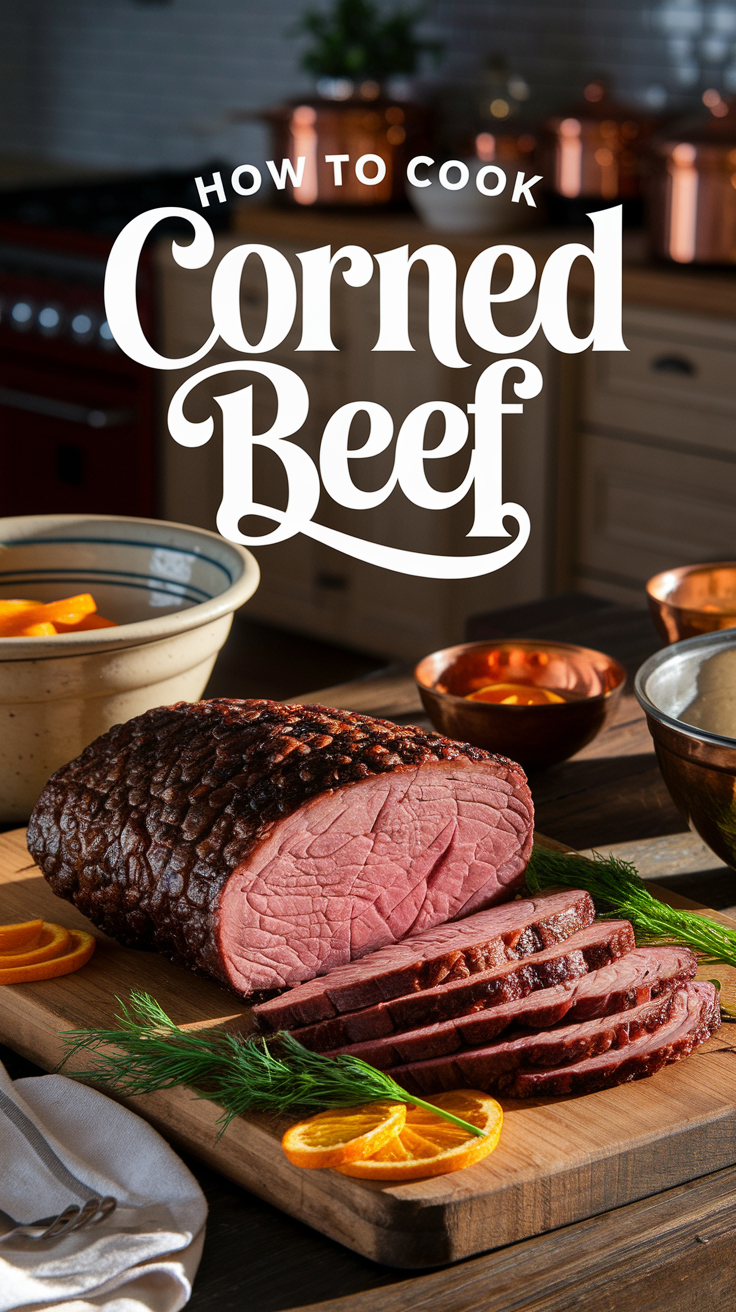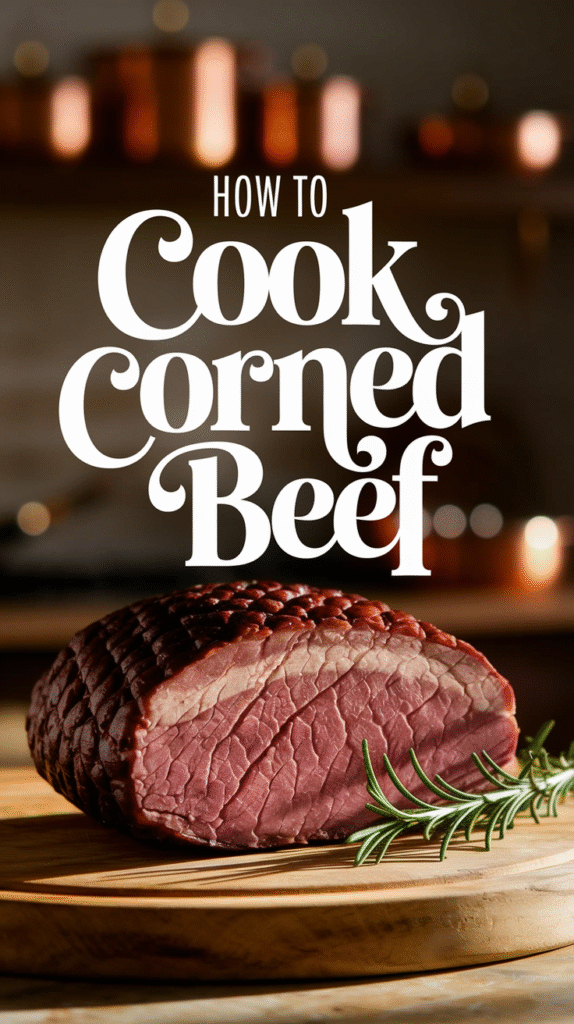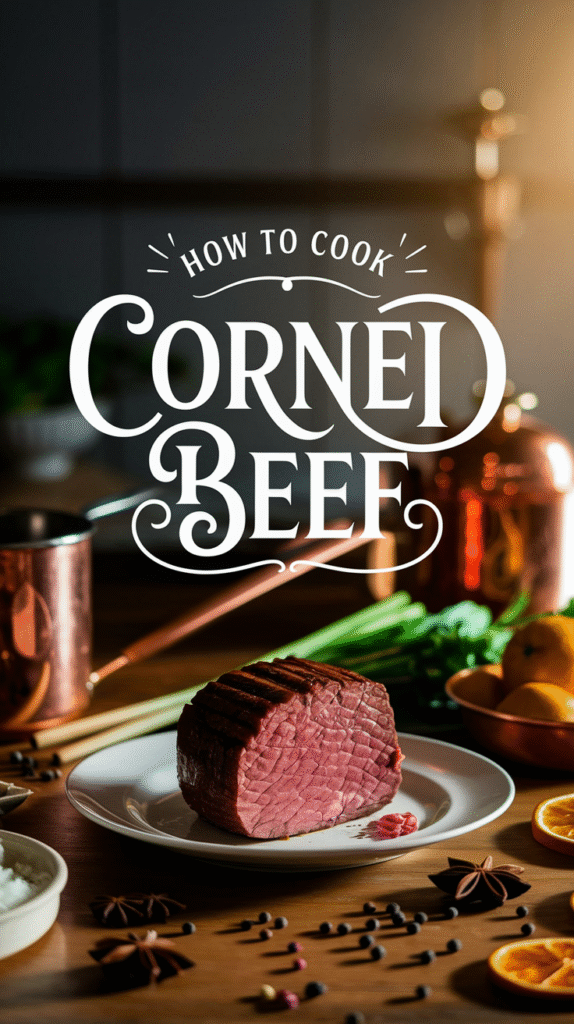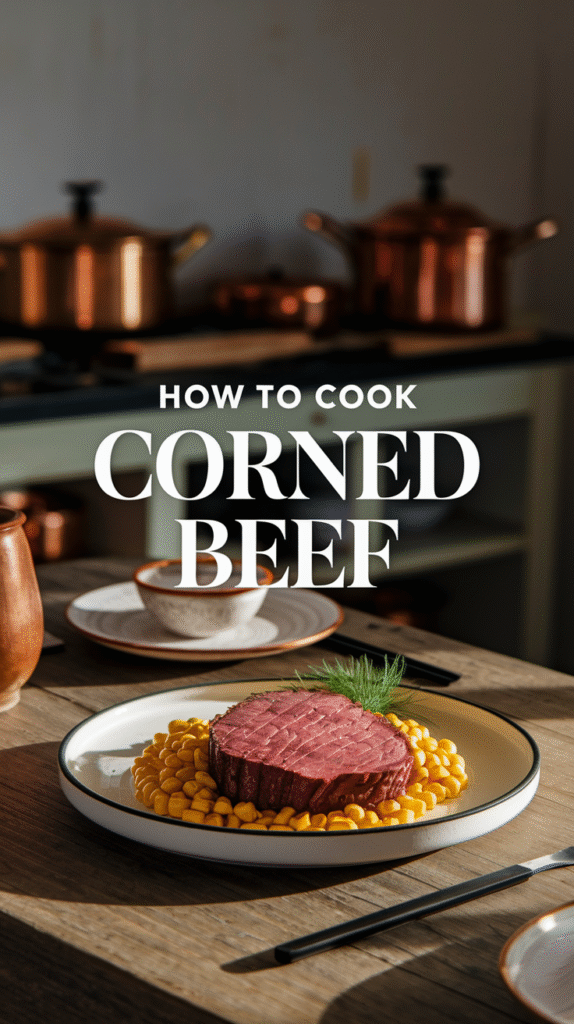Corned beef is a comforting dish that many enjoy, especially around holidays like St. Patrick’s Day. Whether you’re preparing it for a festive gathering or just a cozy dinner at home, knowing how to cook corned beef properly can elevate your meal. Below are various techniques and tips that will help you create a delicious corned beef meal.
Choosing the Right Cut of Corned Beef
Start by selecting the right cut. Corned beef usually comes from the brisket. You can choose between point cut and flat cut:
- Point Cut: This is fattier and often more flavorful, making it ideal for slow cooking.
- Flat Cut: Leaner and easier to slice, this cut is perfect if you’re planning to use the beef for sandwiches.
Cooking Methods: Explore Your Options
There are several ways to cook corned beef, and each method produces its own unique texture and flavor.
Boiling
Boiling is a traditional way to prepare corned beef. This method is simple and yields tender meat.
- Place the corned beef in a large pot. Cover with water, making sure the meat is fully submerged.
- Add the seasoning packet that usually comes with the beef. Feel free to add additional ingredients like garlic and bay leaves for extra flavor.
- Bring the water to a boil, then reduce the heat to a simmer. Cover and cook for 2.5 to 3 hours, or until the meat is fork-tender.
Slow Cooking
If you want to set it and forget it, the slow cooker is your best friend.
- Place the corned beef in the slow cooker, adding the seasoning packet and some added vegetables like carrots and potatoes.
- Add just enough water or broth to cover the meat.
- Cook on low for 8-10 hours or on high for 4-5 hours, depending on your schedule.
Oven Roasting
For a crispy exterior, oven roasting is an excellent choice.
- Preheat your oven to 300°F (150°C).
- Place the corned beef in a roasting pan and cover it with foil.
- Roast for about 3 hours. Uncover the pan for the last 30 minutes to develop a nice crust.
Pressure Cooking
A pressure cooker can significantly reduce cooking time while keeping the meat juicy and tender.
- Add the corned beef, seasoning, and a cup of liquid to the pressure cooker.
- Seal the lid and cook on high pressure for about 90 minutes.
- Let the pressure release naturally for 10-15 minutes before opening.
Flavor Builders
Regardless of your cooking method, adding flavor boosters enhances your corned beef experience. Consider the following:
- Beer or Cider: Add flavor depth by cooking in beer or hard cider.
- Spices: Feel free to add additional spices like peppercorns, mustard seeds, or cloves.
- Vegetables: Include potatoes, carrots, and onions for a complete meal.
Serving Suggestions
Once your corned beef is perfectly cooked, it’s time to serve it. Here are some ideas:
- Slice it thin for classic sandwiches with mustard.
- Serve with traditional sides like cabbage and boiled potatoes.
- Use leftovers for hash or corned beef tacos the next day.
Storing Leftovers
If you have corned beef left over, don’t waste it! Allow it to cool, then wrap it tightly and refrigerate for up to 4 days. You can also freeze it for longer storage.
Cooking corned beef at home is not only rewarding but also allows you to create a dish tailored to your taste. With these techniques and tips, you’re set to impress your family and friends. For more detailed recipes and ideas, check out helpful resources on Food Network or Serious Eats. Enjoy your cooking adventure!
The History and Origins of Corned Beef
Corned beef has a rich and fascinating history that dates back centuries. Its origins can be traced back to the process of preserving meat, which was essential for survival before modern refrigeration methods became available. The term “corned” comes from the large grains of salt, known as “corns of salt,” used in the brining process that adds flavor and helps to preserve the meat.
Ultimately, the practice of preserving beef has roots that span various cultures and regions. The ancient Celts used salt to preserve flesh, a method that has evolved over time into the corned beef we know today. By the Middle Ages, corned beef gained popularity, particularly in England. Meat was packed in coarse salt and left to cure, creating a product that could last months. This was especially useful for long voyages, as it ensured that sailors had enough food to eat during their travels.
The Jewish community later adopted the practice, especially among Ashkenazi Jews in Eastern Europe. They prepared their corned beef with a unique set of spices and seasonings, which included garlic and peppercorns, resulting in a flavor profile distinct from its non-Jewish counterparts. The brining process was crucial for this community, as it aligned with dietary laws that required meat to be kosher.
In the 19th century, corned beef became a staple for Irish immigrants in the United States. When they arrived, they found it an affordable alternative to pork, which had been more common in Ireland. Corned beef was often served with cabbage and potatoes, creating an iconic meal that would become synonymous with St. Patrick’s Day celebrations in America. The dish is a symbol of Irish heritage today, despite its American roots, as it reflects the blending of different cultures and traditions in the melting pot that is the U.S.
One interesting take on corned beef’s popularity is its association with Jewish delis, particularly in cities like New York. Here, the sandwich, made from thick slices of corned beef on rye bread, has become a staple of the deli culture. The combination of tender meat and tangy mustard has a broad appeal, keeping the tradition alive well into the modern age.
The process of making corned beef has also adapted over the years. Commercial production methods now utilize spices and brining solutions that differ from home recipes. While many people still prefer to create their corned beef using traditional recipes, the convenience of store-bought versions makes it accessible to almost everyone. Yet, for those who wish to create corned beef at home, several guides detail this method, emphasizing the importance of each ingredient in achieving the desired flavor.
In recent years, corned beef has transcended its cultural boundaries and found its way into many cuisines worldwide. Chefs are continually experimenting with this versatile meat, incorporating it into various dishes from breakfast hash to gourmet tacos. Such innovations highlight corned beef’s ability to adapt to new ingredients and cooking techniques, reflecting the evolution of culinary preferences.
For those interested in exploring the history and culinary applications of corned beef, several resources provide in-depth insights:
- New York Public Library – For historical documents and archives related to food and culture.
- History.com – Offers a comprehensive overview of corned beef and its significance in various cultures.
- Food Timeline – Details the evolution of various meats, including corned beef.
As a versatile ingredient, corned beef continues to be celebrated not only for its flavors but also for its storied past. From its roots in ancient preservation techniques to its role in contemporary cuisine, corned beef remains a beloved dish that resonates with many. Its journey reflects the movement of cultures and the blending of traditions, ensuring that corned beef maintains its status as a cherished food across generations.
| Period | Key Developments |
|---|---|
| Middle Ages | Use of coarse salt to preserve various meats, including beef. |
| 19th Century | Irish immigrants popularized corned beef in the U.S., leading to its association with St. Patrick’s Day. |
| Modern Era | Continued popularity in delis and adaptation in global cuisine. |
As you explore the world of corned beef, remember that it is more than just a dish; it’s a reflection of human ingenuity in the quest for sustenance. Whether enjoyed simply or as part of a gourmet meal, corned beef carries a history that enriches every bite.
Creative Ways to Serve Leftover Corned Beef
Leftover corned beef can be a delightful treasure in your kitchen, offering numerous creative ways to elevate your meals. Whether you’re looking to whip up lunch, dinner, or even a hearty breakfast, the versatility of corned beef opens doors to inventive and satisfying dishes. Below are some engaging ideas for transforming your leftover corned beef into exciting new meals.
Corned Beef Hash
One of the most popular dishes to make with leftover corned beef is a classic corned beef hash. Here’s an easy recipe you can follow:
- Ingredients:
- 2 cups chopped leftover corned beef
- 2 cups diced potatoes
- 1 onion, diced
- 2 tablespoons olive oil or butter
- Salt and pepper to taste
Instructions: In a skillet, heat the oil or butter over medium heat. Add onions and potatoes, cooking until golden brown. Stir in the corned beef and cook until heated through. Season with salt and pepper.
Reuben Sandwiches
Reuben sandwiches are a classic way to use leftover corned beef. Here’s how you can create this delicious sandwich:
- Ingredients:
- 2 slices of rye bread
- 3-4 ounces of sliced corned beef
- 2 slices Swiss cheese
- ¼ cup sauerkraut
- 1 tablespoon Russian or Thousand Island dressing
Instructions: Spread dressing on one side of each slice of bread. Layer corned beef, Swiss cheese, and sauerkraut. Top with the other slice, dressing side down. Grill on medium heat until the bread is crusty and the cheese melts.
Corned Beef Tacos
For a fun twist, consider making corned beef tacos. This dish adds a festive flair to your meal while being easy to assemble:
- Ingredients:
- Corned beef, shredded
- Taco shells (soft or hard)
- Sour cream
- Salsa or pico de gallo
- Shredded lettuce and cheese
Instructions: Warm taco shells, fill them with shredded corned beef, and top with desired toppings such as salsa, sour cream, and shredded lettuce.
Corned Beef Fried Rice
Transform your leftover corned beef into an Asian-inspired dish with corned beef fried rice:
- Ingredients:
- 3 cups cooked rice (preferably day-old)
- 1 cup chopped corned beef
- 1 cup mixed vegetables (peas, carrots, etc.)
- 2 eggs, beaten
- 3 tablespoons soy sauce
- 2 green onions, sliced
Instructions: In a large skillet or wok, scramble the eggs and set aside. Add the mixed vegetables and cook until tender. Stir in the rice, corned beef, and soy sauce, cooking until heated through. Combine scrambled eggs and garnish with green onions.
Corned Beef Salad
For a lighter option, consider a corned beef salad. This can be a refreshing way to enjoy the meat while incorporating healthy greens:
- Ingredients:
- Mixed greens (spinach, arugula, etc.)
- 1 cup corned beef, shredded
- Cherry tomatoes, halved
- Cucumber, sliced
- Salad dressing of your choice
Instructions: Toss greens, corned beef, tomatoes, and cucumber in a bowl. Drizzle with dressing before serving.
Leftover corned beef can invite creativity into your kitchen. Whether you decide on a rustic hash, a delightful sandwich, or a global-inspired dish like fried rice or tacos, you’ll find that there are countless possibilities. Discover more recipes and ideas at Food Network or explore various cooking tips at Serious Eats.
Experimenting with leftover corned beef not only helps reduce food waste but also adds a flavorful twist to your meals. So, don’t let that delicious corned beef go to waste—get creative and enjoy!
Comparing Cooking Methods: Boiling vs. Baking Corned Beef
When it comes to preparing delicious corned beef, the cooking method you choose plays a big role in the final taste and texture. Two popular methods are boiling and baking. Each approach has its unique advantages and will yield slightly different results. Understanding these differences can help you decide which method is best for your meal. Let’s dive into the details.
Boiling Corned Beef
Boiling is perhaps the most traditional method for cooking corned beef. This method is simple, requiring minimal preparation and fostering a tender, juicy outcome. Here are the steps and benefits associated with boiling corned beef:
- Preparation: Start by rinsing the corned beef brisket under cold water. This helps to remove excess salt. Place the brisket in a large pot and cover it with water.
- Add Aromatics: Enhance the flavor by adding spices such as black peppercorns, bay leaves, garlic, and mustard seeds. Some also choose to add vegetables like carrots and potatoes during the cooking process.
- Cooking Time: Bring the water to a boil, then reduce the heat to a low simmer. Cooking time typically ranges from 2.5 to 3 hours for a 3 to 4-pound brisket.
- Checking Doneness: Use a meat thermometer to ensure that the internal temperature reaches at least 190°F for optimal tenderness.
The result of boiling corned beef is often a dish that is flavorful and easy to slice. It’s perfect for assembling classic dishes like sandwiches or enjoying with cabbage.
Baking Corned Beef
Baking corned beef is a less common method but offers a unique flavor profile. This technique can create a crispy exterior while keeping the inside tender. Here’s how to bake corned beef:
- Preparation: Start by preheating your oven to 350°F. Rinse the corned beef brisket and pat it dry. Place it in a roasting pan.
- Add Seasoning: Coat the brisket with a mixture of brown sugar, mustard, and optionally, some spices from the traditional corned beef seasoning packet.
- Covered Baking: Cover the pan tightly with aluminum foil. Bake for about 2 to 2.5 hours. The moisture will help keep the beef juicy.
- Finishing Touch: For a crispy glaze, remove the foil for the last 30 minutes of cooking. You can even baste the beef with its juices or additional mustard mixture.
Baked corned beef yields a flavorful crust, making it suitable for dinner parties or special events. The added sweetness from the sugar mixture pairs remarkably with the salty flavor of the brisket.
Comparing Texture and Flavor
| Cooking Method | Texture | Flavor | Cooking Time |
|---|---|---|---|
| Boiling | Tender, juicy | Classic, hearty | 2.5 – 3 hours |
| Baking | Crispy exterior, tender inside | Sweet, robust | 2 – 2.5 hours |
Ultimately, your choice between boiling and baking corned beef will depend on your taste preferences and the dining occasion. Boiling is traditional and easy, ideal for a cozy family meal. Baking offers a delicious alternative perfect for impressing guests on special occasions.
To really master the art of cooking corned beef, you can explore tips and recipes from established culinary resources. Check out [The Spruce Eats](https://www.thespruceeats.com) for recipes, or visit [Food Network](https://www.foodnetwork.com) to see how chefs approach this classic dish. These sites are great for additional insights tailored to different preferences and cooking styles.
Whether you choose to boil or bake, you’ll be rewarded with a dish that’s perfect for celebrations or a comforting family meal. Enjoy experimenting with these two cooking methods to discover your favorite version of corned beef!
Essential Side Dishes to Pair with Corned Beef Meals
Corned beef is a flavorful dish that many people enjoy, especially during festive occasions like St. Patrick’s Day. To enhance your corned beef meal, serving side dishes that complement its rich taste is essential. Here are some fantastic options that will elevate your dining experience.
Vegetable Sides
When it comes to vegetables, you have various choices that can add color and nutrition to your corned beef meal. Consider these:
- Cabbage: A classic pairing, boiled or sautéed cabbage brings a subtle crunch and sweetness that balances the saltiness of the beef.
- Carrots: Roasted or glazed carrots offer a touch of sweetness that contrasts beautifully with the savory beef.
- Potatoes: Whether mashed, roasted, or in the form of potato salad, potatoes are a hearty and satisfying side.
Starch Sides
Starches are great companions to corned beef. They not only fill you up but also absorb the flavors of the meat:
- Colcannon: This traditional Irish dish combines mashed potatoes with cabbage or kale, creating a deliciously creamy side.
- Rice Pilaf: Infused with herbs and spices, rice pilaf offers a light contrast to corned beef, making it a delightful option.
- Irish Soda Bread: This bread is perfect for soaking up juices from the corned beef, and its slightly sweet flavor pairs well with the dish.
Salads
Fresh salads can introduce a refreshing element to the meal. Here are a few tasty options:
- Cucumber Salad: Light and crisp, a cucumber salad dressed in vinegar or yogurt adds a nice tang that cuts through the richness of the beef.
- Beet Salad: Roasted beets with feta cheese create a colorful and flavorful side that complements the meat well.
- Garden Salad: A simple garden salad with mixed greens, tomatoes, and a light vinaigrette can refresh your palate.
Comfort Food Sides
If you’re in the mood for some comfort food, these sides will not disappoint:
- Macaroni and Cheese: Creamy and cheesy, this dish adds richness and a fun twist to your corned beef meal.
- Baked Beans: Their sweet and savory flavors pair exceptionally well with corned beef, enhancing the overall experience.
- Spring Rolls: These can be filled with veggies and served with a dipping sauce for an Asian-inspired side.
Seasoning and Sauces
To take your corned beef to the next level, don’t forget about sauces and condiments:
- Mustard: The sharpness of mustard, particularly Dijon, can elevate the flavors of the corned beef superbly.
- Horseradish: This spicy condiment adds a zesty kick that pairs beautifully with the salty meat.
- Gravy: A rich, homemade gravy can soak into the sides and create a delightful flavor blend.
Pairing Recommendations
When planning your meal, consider the following combinations to create a balanced plate:
| Combination | Why It Works |
|---|---|
| Corned Beef + Cabbage + Mustard | The bitterness of cabbage and sharpness of mustard balance the savory meat. |
| Corned Beef + Potatoes + Horseradish | The starchiness of potatoes and the spice of horseradish create a satisfying contrast. |
| Corned Beef + Carrots + Macaroni and Cheese | The sweetness of carrots balances the cheese’s richness, offering a delightful bite. |
Whether you’re hosting a family dinner or a festive gathering, including these essential side dishes will undoubtedly enhance your corned beef meals, creating a well-rounded dining experience.
For more delicious recipes and ideas, check out Food Network and Serious Eats.
Conclusion
Corned beef is not just a dish; it’s a culinary tradition with rich historical roots. Understanding how to cook corned beef opens the door to a variety of flavors, textures, and experiences. Whether you choose to boil or bake it, mastering the techniques ensures a tender and flavorful result that you can proudly serve to family and friends.
As we’ve explored, corned beef has an intriguing history that dates back centuries, allowing you to appreciate every bite you take by knowing its origins. What’s more, when you find yourself with leftovers, there are countless creative ways to repurpose corned beef into new and exciting dishes—think sandwiches, hash, or even salads that can rejuvenate your meals.
Don’t forget to consider essential side dishes that complement your corned beef dinner. From cabbage and potatoes to pickles and mustard, these pairing ideas enhance your dining experience and highlight the star of the plate.
The choice between boiling and baking comes down to personal preference. Boiling may yield a more tender meat, but baking can create a delightful crust that adds texture. Experimenting with both methods will help you determine which style you prefer.
Ultimately, cooking corned beef is about celebrating flavor, history, and creativity. Embrace this dish and explore all its facets, because there’s more to corned beef than a heartwarming meal; it’s an opportunity to connect with culinary traditions while enjoying delicious food. So, roll up your sleeves, dive into your kitchen, and let the journey of cooking corned beef begin!







Leave a Reply